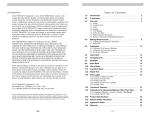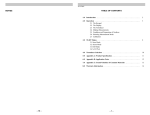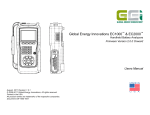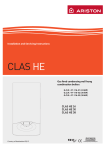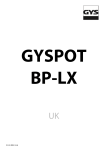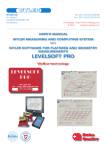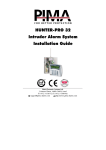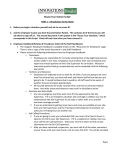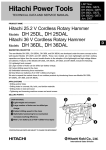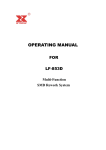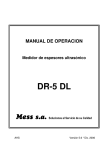Download PDF Instruction Manual - Electromatic Equipment Co., Inc
Transcript
OI908L NOTES TABLE OF CONTENTS 1.0 Introduction . . . . . . . . . . . . . . . . . . . . . . . . . . . . . . . . . . . . . . . . 2 2.0 Precautions . . . . . . . . . . . . . . . . . . . . . . . . . . . . . . . . . . . . . . . . 2 3.0 Overview of Gauge. . . . . . . . . . . . . . . . . . . . . . . . . . . . . . . . . . 3 3.1 Gauge 3.6 Display Backlight 3.2 Contents of Kit 3.7 Probe Zero Plate 3.3 Probe 3.8 Connector Probe & Test Plate 3.4 Keypad 3.9 Battery Compartment (Battery Replacement) 3.5 LCD Display 4.0 Getting Started . . . . . . . . . . . . . . . . . . . . . . . . . . . . . . . . . . . . . 10 4.1 Connecting The Probe 4.4 Changing Units — inches to mm 4.2 Turn On The Power 4.5 Checking Calibration with the Test Plate 4.3 “Zeroing” The Probe 4.6 Preparation of the Surface 5.0 Quick Start Instructions — Steel Thickness . . . . . . . . . . . . 6.0 Calibration For Measuring Thckness Of Materials Other Than Steel . . . . . . . . . . . . . . . . . . . . . . . . 6.1 Acoustic Velocity Table 6.2 Changing Calibration — Acoustic Velocity is Known 6.3 Changing Calibration — Acoustic Velocity is Not Known 6.4 Performing a 2-Point Calibration – 36 – 13 15 7.0 Description of Measuring Modes . . . . . . . . . . . . . . . . . . . . . 20 8.0 Alarm & Beeper Modes . . . . . . . . . . . . . . . . . . . . . . . . . . . . . . 22 9.0 Measuring Procedure . . . . . . . . . . . . . . . . . . . . . . . . . . . . . . . 9.1 General Notes On Measurements 9.2 Measurements Of Pipes Or Cylindrical Parts 9.3 Measurements On Materials At High Temperatures 24 10.0 Using the Built-in Data Logger . . . . . . . . . . . . . . . . . . . . . . . 10.1 Storing Data 10.2 Clearing Individual Storage Locations 10.3 Clearing the Contents of a File 10.4 Clearing Data From All Files Simultaneously 27 11.0 Downloading Data To A Computer Or Printer. . . . . . . . . . . 11.1 Download Data to a Computer 11.2 Download Data to a Printer 11.3 Download Data to Check•Line P-25DL Printer 30 12.0 Specifications . . . . . . . . . . . . . . . . . . . . . . . . . . . . . . . . . . . . . . 33 13.0 Material Safety Data Sheet (MSDS). . . . . . . . . . . . . . . . . . . . 34 14.0 Warranty . . . . . . . . . . . . . . . . . . . . . . . . . . . . . . . . . . . . . . . . . . 35 –1– 14.0 WARRANTY 1.0 INTRODUCTION The CHECK•LINE® TI-25DL Ultrasonic Thickness Gauge measures the wall thickness of metals, glass, ceramics and many rigid plastics. This gauge uses the “pulse-echo” principle of ultrasonic testing where a short ultrasonic signal is transmitted from the probe. The signal travels through the measurement sample until it is reflected back towards the probe from the back side of the material. The elapsed time for the complete cycle is measured and converted to an accurate thickness reading. The TI-25DL can be used to measure the extent of corrosion on the opposite, inaccessible side of the wall by using the “Subtractive Method.” When the thickness of the original wall is known, subtracting the thickness reading obtained from the gauge will determine the extent of corrosion at the point of probe placement. If the original wall thickness is not known, test readings should be made along a grid of equally-spaced points to obtain a profile of the thickness readings. The smallest thickness reading will locate the area of greatest concern. The TI-25DL is factory-set to measure steel. The gauge can be easily adjusted for accurate thickness readings on other materials. Refer to Sections 6.0 through 6.3. To change the measuring units from inch (factory setting) to mm refer to Section 4.4. The TI-25DL incorporates a built-in data logging system which permits the end user to store up to 1000 measurements in 10 separate batches. The stored data can be printed or downloaded to a PC using the supplied Data Transfer Program and serial cable. 2.0 PRECAUTIONS Do not use the standard probe in applications where material temperatures exceed 200 °F (100 °C) as the probe will be damaged. Special High Temperature Probes should be used. Consult factory. Keep the gauge free of dust (especially metal powders, carbon, etc.) as they will damage the gauge. Use a damp cloth to clean the gauge after use. DO NOT USE CHECMICAL SOLVENTS OF ANY KIND. –2– ELECTROMATIC Equipment Co., Inc. (ELECTROMATIC) warrants to the original purchaser that this product is of merchantable quality and confirms in kind and quality with the descriptions and specifications thereof. Product failure or malfunction arising out of any defect in workmanship or material in the product existing at the time of delivery thereof which manifests itself within one year from the sale of such product, shall be remedied by repair or replacement of such product, at ELECTROMATIC’s option, except where unauthorized repair, disassembly, tampering, abuse or misapplication has taken place, as determined by ELECTROMATIC. All returns for warranty or non-warranty repairs and/or replacement must be authorized by ELECTROMATIC, in advance, with all repacking and shipping expenses to the address below to be borne by the purchaser. THE FOREGOING WARRANTY IS IN LIEU OF ALL OTHER WARRANTIES, EXPRESSED OR IMPLIED, INCLUDING BUT NOT LIMITED TO, THE WARRANTY OF MERCHANTABILITY AND FITNESS FOR ANY PARTICULAR PURPOSE OR APPLICATION. ELECTROMATIC SHALL NOT BE RESPONSIBLE NOR LIABLE FOR ANY CONSEQUENTIAL DAMAGE, OF ANY KIND OR NATURE, RESULTING FROM THE USE OF SUPPLIED EQUIPMENT, WHETHER SUCH DAMAGE OCCURS OR IS DISCOVERED BEFORE, UPON OR AFTER REPLACEMENT OR REPAIR, AND WHETHER OR NOT SUCH DAMAGE IS CAUSED BY MANUFACTURER’S OR SUPPLIER’S NEGLIGENCE WITHIN ONE YEAR FROM INVOICE DATE. Some State jurisdictions or States do not allow the exclusion or limitation of incidental or consequential damages, so the above limitation may not apply to you. The duration of any implied warranty, including, without limitation, fitness for any particular purpose and merchantability with respect to this product, is limited to the duration of the foregoing warranty. Some states do not allow limitations on how long an implied warranty lasts but, not withstanding, this warranty, in the absence of such limitations, shall extend for one year from the date of invoice. ELECTROMACTIC Equipment Co., Inc. 600 Oakland Ave. Cedarhurst, NY 11516—USA Tel: 1-800-645-4330/ Tel: 516-295-4300/ Fax: 516-295-4399 Every precaution has been taken in the preparation of this manual. Electromatic Equipment Co., Inc., assumes no responsibility for errors or omissions. Neither is any liability assumed for damages resulting from the use of information contained herein. Any brand or product names mentioned herein are used for identification purposes only, and are trademarks or registered trademarks of their respective holders. – 35 – 13.0 MATERIAL SAFETY DATA SHEET (MSDS) 3.0 OVERVIEW OF GAUGE Section 1— Product Identification Product Name: TI-25DL Manufacturer: Electromatic Equpt. Co. Generic Name: Ultrasonic Couplant NFPA Hazardous Materials Identification System (est) Health 0 Flammability 0 Reactivity 0 3.1 Gauge Section 2— Hazardous Ingredients This material does not contain any ingredients having known health hazards in concentrations greater than 1%. This material does not contain any known or suspected carcinogens. Section 3 — Physical Data (nominal) Boiling Point: >220°F Vapor Pressure: N/A Specific Gravity: >1.0Z pH: 7.35 – 7.9 Vapor Density: N/A Freezing Point: <20°F Evaporation Rate: N/A Solubility in Water: complete Acoustic Imp.: 1.726 x 106 Appearance and Odor: water white, opaque gel; bland odor Section 4 — Fire and Explosive Hazard Data Flash Point: none Upper Exposure Limit: none Special Fire Fighting Procedures: N/A Unusual Fire and Explosion Hazards: none Probe Zero Test Plate (battery compartment cover) Probe Receptacles Lower Exposure Limit: none Extinguishing media: N/A Section 5 — Reactive Data Stability: Stable Conditions to Avoid: none Incompatibility (Materials to Avoid): none known Hazardous Polymerization: will not occur Hazardous Decomposition or Byproducts: none known Section 6 —- Health Hazard and First Aid Data Routes of Entry1: Skin: not likely Ingestion: not normally Effects of Overexposure: Acute: May cause temporary eye irritation Backlit LCD Display Red LED Green LED Eyes: not normally Membrane Keypad Inhalation: no Chronic: none expected First Aid Procedures: Skin: Remove with water if desired. Eyes: Flush with water for 15 minutes. Ingestion: For large quantities, induce vomiting and call a physician Inhalation: N/A Section 7 - Storage and Handling Information Precautions to be taken in handling and storage: Store between 20 °F and 120 °F. Spills are slippery and should be cleaned up immediately. Steps to be taken in case material is released or spilled: Pick up excess for disposal. Clean with water. Waste disposal method: Dispose of in accordance with federal, state, and local regulations. Bottom of Gauge Section 8 — Control Measures Respiratory Protection: not required Ventilation: not required Protective Gloves: on individuals demonstrating sensitivity to TI-25 Eye Protection: as required by working conditions Other Protective Equipment: not required 1. TI-25DL contains only food grade and cosmetic grade ingredients. – 34 – Serial Output Port Probe –3– 3.2 Contents Of Kit The TI-25DL is supplied as a complete kit with the following: a. Gauge a g b. Two (2) AA batteries (installed in gauge) c. Probe/cable assembly d. 4 oz. Bottle of coupling fluid e. Serial Output cable f. Data Trasfer software program g. Foam-filled carrying case c Not shown: NIST-traceable calibration certificate and Operating instruction manual 12.0 SPECIFICATIONS d f e 3.3 Probe The probe transmits and receives the ultrasonic sound waves which the TI-25DL uses to calculate the thickness of the material being measured. The probe must be used correctly in order for the TI-25DL to produce accurate and reliable results. A small amount of “coupling” fluid, commonly called “couplant” is used to insure that there are no air gaps between the probe and the material surface. Grasp the probe by the knurled aluminum housing and place it on top of the material surface. Apply moderate pressure to the top surface of the probe with your thumb (A) or index finger (B) to stabilize the probe and to keep the wearface seated flat against the measurement surface. A B Range* 0.025–6.00" (0.60–150.0 mm) Other ranges available with optional probes. Resolution .001" (0.01 mm) Display 4 1⁄ 2 -Digit, 0.5" Backlit LCD Velocity Range 0.0787 – 0.3937 in./µs (2000–10,000 m/sec.) Probe 7.5 MHz, 0.25" Diameter (6.35 mm) Probe Wearface PEEK (Polyethylethylkeytone) Cable 4 ft. (1.2 m) waterproof cable with non-polarized, quick-disconnect connectors. Optional lengths up to 100 ft. (30 m). Temp. Limits Ambient: –20 to 120 °F (–30 to 50 °C) Material: 0 to 200 °F (–20 to 100 °C) Special high temperature probes are optionally available. Battery Type Two AA batteries Battery Life 200 hours Weight 10 ounces (280 g), with battery Size 2.5 x 4.5 x 1.25" (64 x 114 x 32 mm) Accessories Included Warranty Probe/cable assembly. 4oz. bottle of coupling fluid, NIST Calibration Certificate, 2 AA batteries, operating instructions, hard-plastic carrying case. Gauge: 5 years Probe: 90 days *Measuring Range indicated is for steel. Actual range for other materials will vary based upon the material’s sonic velocity and attenuation. Probe Wearface –4– – 33 – 3. Press the key to enter the file setup. The currently selected file number will be displayed (F-01, F-02 .... F-10). 3.4 Keypad CAL MODE 4. Press the key to select the currently displayed File Number for printing or press the or keys to index the File Number to the desired File Number to be printed. 5. Press the key to select the desired file for printing. The display will alternately flash “FILE” and “F-XX” (where “XX” is the File Number 01, 02 ..10). MEM SEND PROBE ZERO MODE 6. Press the key once. The display will alternately flash “Prnt” and “F-XX” (where “XX” is the File Number 01, 02 ..10). 7. Press the key to print a report using the data stored in the selected File Number. MEM 8. Press the key at any time to exit the data logging mode and return to measurement mode. 11.3 Download Data to Check•Line P-25DL Printer Perform all of the steps detailed above (Sec. 11.2, steps 1–8), except in step 6, instead of selecting “Prnt,” select “LISt.” PROBE ZERO CLR ON OFF The TI-25DL is supplied with a membrane keypad mounted on the front of the instrument body. It consists of nine (9) keys, each performing one or more functions as described below. The MODE key is used to toggle through the various features and settings including alarm mode, beeper, back light, units, scan mode and differential mode. The MODE key is used in conjunction with the UP & DOWN ARROW and SEND keys to enable and disable the various features and settings. The MEM key enables/disables the data logging features of the TI-25DL. This key is used in conjunction with the UP & DOWN ARROW keys as well as the SEND and CLR keys. These keys in different combinations control all of the data logging functions. For additional information, refer to Section 10.0, Using the Data Logger. The PROBE ZERO key is used to “zero” the probe in a similar way as a micrometer is “zeroed” before use. If the tool is not zeroed correctly, the measurements will not be accurate. The UP ARROW key has three (3) functions. In the Calibration mode, this key is to increase numeric values on the display. An "auto-repeat" function is built in, so that when the key is pressed and held down, the numeric values will change at an increasing rate. When the Mode function is activated, the UP ARROW key scrolls through the various features and settings of the TI-25DL. When the Memory mode is activated, the UP ARROW key scrolls through the various batches, storage locations and functions of the data logger. For additional information, refer to Section 10.0, Using the Data Logger. SEND – 32 – The SEND key is used to store measured values to internal storage locations or downloading stored data to external devices such as a serial printer or computer. The SEND key is also used to select data logging functions in the TI-25DL. For additional information, refer to Section 10.0, Using the Data Logger. –5– CAL CLR ON OFF The DOWN ARROW key has three (3) functions. In the Calibration mode, this key is to decrease numeric values on the display. An "auto-repeat" function is built in, so that when the key is pressed and held down, the numeric values will change at an increasing rate. When the Mode function is activated, the DOWN ARROW key scrolls through the various features and settings of the TI-25DL. When the Memory mode is activated, the DOWN ARROW key scrolls through the various batches, storage locations and functions of the data logger. For additional information, refer to Section 10.0, Using the Data Logger. 11.1 Download Data to a Computer Once the TI-25DL is connected to the computer and the communications program is running, the data can be downloaded by performing the following steps: The CAL key is used to enter and exit the Tl-25DL’s two Calibration modes. The Acoustic Velocity Calibration mode is used to adjust the acoustic velocity for the material to be measured. The Measurement Calibration mode is used to increase or decrease the displayed thickness reading to calibrate to a known thickness value. 3. Press the or “Send” and “ALL”. The CLR key is used exclusively with the data logging feature to clear the contents of a batch or delete individual measurement values. The CLR key is also used to store an "obstruct" (ObSt) to an individual storage location. The "ObSt" symbol would indicate that the user was unable to take a reading at that specific location. For additional information, refer to Section 10.0, Using the Data Logger. The ON/OFF key is used to turn the power on as well as turning the power off. If the Tl-25DL is idle for five (5) minutes the gauge will automatically power off. 1. Turn on the TI-25DL power by pressing the 2. Press the key. key to activate the data logger. The display will alternately flash “FILE” and the “F-XX” (where XX is the currently selected File Number). Please note that there are 10 separate files (F-01 through F-10) key twice until the display alternately flashes 4. Press the key to download (send) the stored data from all of the Files to the computer. 5. Press the key to exit the data logging mode and return to measurement mode. 11.2 Downloading Data to a Printer In addition to the possibility of downloading the stored data to a PC, the TI-25DL can print a “pre-formatted” report on a serial printer. This report can also be sent to a PC and then printed. The user first must select a specific File Number (F-01 ... F10) for printing. Set the communications parameters for the printer to: Data Bits = Parity = Stop Bits = Baud Rate = 8 None 1 1200 To print the pre-formatted report to a serial printer or PC perform the following steps. 1. Turn on the TI-25DL power by pressing the 2. Press the key. key to activate the data logger. The display will alternately flash “FILE” and the “F-XX” (where XX is the currently selected File Number). Please note that there are 10 separate files (F-01 through F-10) –6– – 31 – 11.0 DOWNLOADING DATA TO A COMPUTER OR PRINTER After measurements have been stored in the TI-25DL’s built-in data logger, the user may want to transfer the data to a computer or printer. The steps required to download the data are as follows: 1. Connect one end of the serial output cable (supplied) to the TI-25DL serial output connector located on the bottom of the gauge. The protective plastic plug inserted into this connector should first be removed. Store this protective plug for future use. Note: Line up the red dot on the cable connector with the red dot on the serial output receptacle, then push the connector into the receptacle. 2. Connect the other end of the serial output cable to the 9-pin serial port of the PC. If necessary, the user can use a DB9-to-DB25 converter to connect it to the 25-pin serial port on the PC. 3. Start the Data Transfer Program or other communications program (i.e. Microsoft Windows™ 3.1 TERMINAL Program or Windows™ 95 / 98 HYPER TERMINAL Program). Note: If using a program other than DataComm (supplied), be sure to set the Set the communications parameters in the software program to: Data Bits = Parity = Stop Bits = Baud Rate = 8 None 1 9600 (when trying to print a “Report”— pre-formatted report format, set the baud rate to 1200) 4. Set the communications port (“Com Port”) in the software to the serial port where the TI-25DL cable is connected. 3.5 LCD Display The LCD Display provides the operator with important information. + INMM/µs 1.8.8.8.8 • Measurement values • Acoustic velocity values • Units of measure • Bar graph signal stability indicator • Configuration messages The numeric portion of the display consists of 4-digits preceded by a leading "1", and is used to display numeric values, as well as occasional simple words, to indicate the status of various settings. When the TI-25DL is displaying thickness measurements, the display will retain the last measured value, until a new measurement is performed. + INMM/µs 1.8.8.8.8 The eight vertical bars shown form the Stability Indicator. When the TI-25DL is idle, only the left-most bar and underline will be illuminated. When a measurement is being performed, six or seven bars should be illuminated indicating that it is a stable measurement. If fewer than five bars are illuminated, the TI-25DL is having difficulty obtaining a stable and reliable measurement and the thickness value shown should be ignored, as it is most likely erroneous. + INMM/µs 1.8.8.8.8 + INMM/µs 1.8.8.8.8 + INMM/µs 1.8.8.8.8 When the “IN” indicator is illuminated, the TI-25DL is displaying a wall thickness measurement in INCH units. When the “MM” indicator is illuminated, the TI-25DL is displaying a wall thickness measurement in MM units. 5. Download the data from the TI-25DL (see Section 11.1 for details). + INMM/µs 1.8.8.8.8 – 30 – When the “IN” and the “µs” indicators are illuminated simultaneously, the TI-25DL is displaying an acoustic velocity in inches per microsecond. –7– + INMM/µs 1.8.8.8.8 + INMM/µs 1.8.8.8.8 When the “M” and the “s” are illuminated simultaneously, the TI-25DL is displaying an acoustic velocity in meters per second. When in Differential Measurement mode, the measured values will be displayed as “+” or “-” from a user-set “nominal” value. The “+” and “-” indicator is located next to the “IN” units indicator. 3.6 Display Backlight The TI-25DL is supplied with a user-set Backlight mode. The back light can be set to operate in any of the following three modes: 1. ON The backlight is illuminated whenever the power is on. 2. OFF The backlight is never illuminated (to save battery power) 3. AUTO The backlight is automatically illuminated each time a measurement is made. Note: The factory default setting is “OFF.” To Change Backlight Mode 1. Turn on the TI-25DL power by pressing the key. 2. Press the key to activate the features and settings menu. 3. Press the display. or key until ... "LitE" is shown on the 2. Press the key to activate the data logger. The display will alternately flash “FILE” and the “F-XX” (where XX is the currently selected File Number). 3. Press the key to enter the file setup. The currently selected File Number will be displayed (F-01, F-02 .... F-10). 4. Press the key to select the currently displayed File Number clearing or press the or keys to index the file number to the desired File Number to be cleared of all stored data. 5. Press the key to select the file for clearing. The display will alternately flash “FILE” and “F-XX” (where “XX” is the File Number 01, 02 ..10). 6. Press the key. The display will alternately flash “F-XX” and “CLr”. 7. Press the key to clear the contents of this File Number. The display will show “CLr?” checking to make sure the user wants to clear the contents of the selected File. 8. Press the or press the function. key to confirm the request to clear (erase) the data key to abort this action and exit the data logging Note: The user can press the key at any point to exit the data logging function and return to the measurement mode. 10.4 Clearing Data From All Files Simultaneously If the user would like to clear (erase) the entire contents of the data loggers memory (all Files) perform the following steps: 1. Turn on the TI-25DL power by pressing the 4. Press the key to change the currently selected backlight mode. Each time the SEND key is pressed the backlight mode will change from "Aut0", to "On" to "OFF". 5. Press the key to select the current backlight mode and return to measurement mode. –8– 2. Immediately press the 3. Press the or press the function. key. key. The display will show “CLr? key to confirm the request to clear (erase) the data key to abort this action and exit the data logging – 29 – • An obstruct condition indicated by the symbol “ObSt”. An obstruct condition is recorded when a user has pre-assigned storage locations to measurement locations and a measurement could not be obtained (for any reason) in this location. 6. Take a measurement and press the key to store the measurement in the previously-selected storage location. Note: The data logger will automatically advance to the next storage location within the file. 7. Repeat step #6 as many times as desired. If the “FuLL” symbol is shown on the display when attempting to store a measurement, the data logger is advising the user that the currently-selected storage location already has a measurement stored. The user should first clear the storage location (refer to Section 10.2) or select another unused (empty) storage location for the measurment. 10.2 Clearing Individual Storage Locations Data in any individual storage location can be cleared (erased) and replaced by another measurement or left empty. The procedure for clearing a storage location is as follows: 1. Advance to the storage location that is to be cleared by performing the steps #1 through #5 in Section 10.1 2. Press the key to delete the measurement currently stored in this location. The display will alternately flash the storage location (L001 ... L100) and then the “CLr” symbol. 3. Take another measurement and press the location that was just cleared. key to store it in the 10.3 Clearing The Contents Of A File When desired, a user may erase (clear) the content of an entire file. This will permit the end user to store a new series of measurements in this file starting storage location L001. The procedure to clear the contents of an entire file is as follows: 1. Turn on the TI-25DL power by pressing the – 28 – key. 3.7 Test Plate When first connecting the probe supplied with the TI-25DL, the user should perform a “Probe Zero” as described in Section 4.3. The Probe Zero Test Plate is used for this task. It is located on the top edge of the gauge as shown in the photo below. It also serves as the battery compartment cover Note: The thickness of this plate is not imporatnt, and it should not be used as a Calibration Test Plate. A precision 4-step Test Block is optionally available for this purpose. 3.8 Probe Receptacles & Probe Zero Plate Located on the top edge of the TI-25DL housing are the Probe Receptacles receptacles for the probe and the probe zero plate. Probe Zero Plate The connectors for the probe are non-polarized so the connector at the end of the probe cable can be inserted into this receptacle in either orientation. Make sure the connector is “well seated” in the receptacle. 3.9 Battery Compartment (Changing The Battery) The battery compartment is located Battery Cover under the probe zero test plate. To open the battery compartment, unscrew the probe zero plate by rotating it counterclockwise. The TI-25DL operates on two (2) AA Batteries (1.5 V). If desired, rechargeable batteries may be used. The TI-25DL is shipped with the batteries installed. Insert batteries in the polarity indicated on the rear label. Note: When the display elements begin to flash off and on repeatedly, the batteries are low and should be replaced. –9– 10.0 USING THE BUILT-IN DATA LOGGER 4.0 GETTING STARTED 4.1 Connecting The Probe Grasp the connector located at the end of the probe cable and carefully insert the connector plugs into the receptacle located at the top edge of the gauge. Make sure the connector is fully inserted into the receptacle. The orientation of the plugs does not matter as they are nonpolarized. Refer to Section 3.8 for additional details 4.2 Turn On The Power Press the key. All of the LCD Display elements will momentarily illuminate. The firmware revision will then be momentarily shown (for factory troubleshooting purposes only). Eventually the display will show “0.000” (or “0.00” if using metric units), indicating it is ready for use. Note: 1. The gauge is turned off by pressing the key again. 2. The gauge will automatically power off after 5 minutes of non-use. 3. All settings will be retained in non-volatile memory. 4.3 “Zeroing” The Probe The Probe Zero Plate is used to “zero” the probe for calibration purposes. Normally, this procedure is required only when the probe is connected to the instrument for the first time, but since this process takes less than 10 seconds, we recommend performing the Probe Zero function occasionally as described below. 1. Check that the probe face (wear surface) is clean and free of debris. 2. Place a small drop of the supplied coupling fluid on the built-in Probe Zero Plate located on the top of the gauge. 3. Press the probe firmly against the Plate. 4. The Stability Indicator on the LCD display should have six or seven bars illuminated and a value should be shown in the display. 5. While maintaining probe contact with the Test Plate, press the key. The display will show “Prb0” while the TI-25DL calculates its zero point. Note: The value shown on the display can be recorded and used in the future to confirm that the gauge is functioning properly. – 10 – The TI-25DL incorporates a built-in data logging system that permits the user to store up to 1000 data points. The stored data is grouped into 10 separate files (“batches”) with each file containing a maximum of 100 values. Each measured value is assigned a unique storage location within the file. The user may download the stored data to a computer or to a serial printer. The end user must first select one of the ten (10) available files to store measured values. The user normally would perform the following steps: 1. 2. 3. 4. Select a File Number Select a Storage Location within the file Make a measurement “Send” displayed measured valued to the Storage Location in the File. Detailed procedures are provided in the following sections. 10.1 Storing Data 1. Turn on the TI-25DL power by pressing the key. 2. Press the key to activate the data logger. The display will alternately flash “FILE” and “F-XX” (where “XX” is the File Number 01, 0...10). Please note that there are 10 separate files (F-01, F-02 ... F-10) 3. Press the key to enter the file setup. The currently-selected File Number will be displayed (F-01, F-02 .... F-10). 4. Press the key to select the currently displayed File Number or press the or keys to index the File Number. When the desired File Number is displayed, press the key to select it. 5. Press the key to advance to the first Storage Location (L001) in the selected File. Press the or keys to advance to other Storage Locations within the selected File. The display will alternately flash the storage location (L-XXX, where XXX is the storage location 001, 002 ... 100) within the selected File Number. Each Storage Location can contain one of the following three things: • A measurement value that was previously stored • A clear (empty) location indicated by the symbol “CLr” – 27 – 9.3 Measurements On Materials At High Temperatures When it is necessary to measure wall thickness on surfaces that are in excess of 200 °F (100 °C), special-purpose high temperature probes should be used. These probes are built using special materials and techniques that allow them to withstand high temperatures without damage. Additionally, care must be taken when performing a “Probe Zero” or “Calibration To Known Thickness” using a High Temperature probe. At such elevated temperatures, it is recommended that the user follow these procedures: 1. Perform a calibration procedure on a sample of known thickness (refer to Section 6.3) with the material temperature at or near the temperature that will be encountered during measurement. 2. Remove the probe from the hot surface immediately after a “stable” reading is displayed. Even though the High Temperature Probes are constructed using materials which can withstand high temperatures, the probe can begin to heat up, through thermal expansion and other effects, adversely affecting the accuracy of the measurement. Note: The probe can be cooled by submerging it in water. 4.4 Changing Units — inches to mm The TI-25DL can be set to measure in units of “INCH” or “MM.” The factory default setting is "INCH". To change the units of measure, perform the following: 1. Turn on the TI-25DL power by pressing the key. 2. Press the key to activate the features and settings menu. 3. Press the or key until ... “unit.” is shown on the display. 4. Press the key to change the currently selected units of “INCH” to “MM.” Each time the SEND key is pressed the units will change and the corresponding indicator “IN” or “MM” will flash on and off. 5. Press the key to store the selected units of measure and return to measurement mode. 4.5 Checking Calibration With The Test Plate The Probe Zero Plate can be used to confirm that the gauge is operating properly, however, there are several precautions necessary for proper use. 1. Due to manufacturing tolerances, the thickness of the Probe Zero Plate can vary with each gauge. Therefore, its exact thickness is not reported, and the user must record this value when first performing the Probe Zero Function (refer to Section 4.3). 2. The displayed thickness reading of the Probe Zero Plate will change if the user manually changes the calibration. 4.6 Preparation Of The Surface The TI-25DL can be used to measure thickness over existing paint or coatings as long as the coating is in good condition, is well adhered to – 26 – – 11 – the surface and does not exceed 0.020" (20 mils or 500 microns) in thickness. Please note that the paint or coating thickness will be included in the overall wall thickness measurement. The surface to be measured should be relatively clean and smooth, free of any small particulate, rust or scale. The presence of any of these conditions will prevent stable and reliable readings. Often, a wire brush, sandpaper or scraper will be helpful in cleaning the measurement surface. In situations where the surface is heavily corroded or pitted, a rotary sander, or grinding wheel will be necessary to properly prepare the surface for measurement. If the surface is still “rough” after preparation, using a more viscous couplant fluid similar to petroleum jelly or K-Y jelly will help obtain a stable, reliable measurement. This type of “thick” coupling fluid is a good choice when measuring on vertical surfaces or on the underside as it will help adhere the probe to the measurement surface while also acting as the coupling agent. Extremely rough surfaces such as the “pebble-like” finish of some cast irons, will prove most difficult to measure. These kinds of surfaces act on the sound beam like frosted glass acts on light; the beam becomes diffused and scattered in all directions. Rough surfaces also contribute to excessive wear of the probe, especially in applications where the probe is “scrubbed” along the measurement surface for use in the Scan mode. The probe should be inspected regularly for signs of uneven wear on the probe surface (wearface). If this is detected, the probe should be returned to the factory for repair or replacement. 6. If two materials are press-fitted or laminated together, the gauge will only measure the thickness of the sample that contacts the probe. 9.2 Measurements Of Pipes Or Cylindrical Parts When using the TI-25DL to meaA Perpendicular sure the wall thickness of a pipe, the orientation of the probe is very important to obtain accurate readings. Pipe diameter is greater than 4 inches (100 mm) Position the probe so the centerline of the probe wearface is perpendicular to the long axis of the pipe as shown in illustration “A.” B Parallel Pipe diameter is less than 4 inches (100 mm) Two measurements should be performed at the same location, one with the centerline of the probe perpendicular to the long axis and one parallel (Illustration “B”). The smaller (thinner) of the two measurements should be used as the actual wall thickness at the measurement location. Additionally, on applications on pipe diameters less than 1.5 inches (38 mm), we recommend using the optional V-Block fixture which helps maintain stable probe placement on the rounded measuring surface. – 12 – – 25 – 9.0 MEASURING PROCEDURE 5.0 QUICK START INSTRUCTIONS — STEEL THICKNESS After setting the TI-25DL for the correct acoustic velocity, or retaining the factory-set acoustic velocity for Common Steel, the gauge is ready to take wall thickness measurements. 1. Turn on the power by pressing the key. These Quick Start procedures are intended for those applications where the thickness of steel is to be measured. If a material other than steel will be measured, the gauge must be calibrated for use on this particular material. Refer to Sections 6.0 through 8.0 for additional details. 2. Plug the probe cable into the receptacle at the top of the gauge. Quick Start Instructions 3. Place a small amount of coupling fluid on the surface to be measured. 1. Turn on the power by pressing the 4. Grasp the probe and place it on top of the material surface. Apply moderate pressure to the top face of the probe with your index finger or thumb to stabilize the probe and to keep the wearface seated flat against the measurement surface. 5. The gauge will display the thickness of the steel wall along with the Stability Indicator showing the relative stability of the reading. 6. Repeat steps #3 - #5 as required. 9.1 General Notes On Measurements 1. When the probe is removed from the sample after a measurement, the last reading will be retained on the display. 2. If fewer than five (5) bars of the Stability Indicator are illuminated, the thickness reading displayed is most likely inaccurate. 3. Occasionally, a small film of couplant will be drawn out between the probe and the surface as the probe is removed. When this happens, the TI-25DL may perform a measurement that is larger or smaller than it should be. This phenomenon is obvious when one thickness value is observed while the probe is in contact with the material, and another value after the probe is removed. 4. The gauge will automatically power off after 5 minutes of non-use. 5. The following surface conditions can prevent accurate measurements (refer to Section 4.6 Preparation Of The Surface): • More than 0.020" (20 mils or 500 µm) of paint or other coating • Flaking or loosely adhered coatings • Rough or heavily pitted surface – 24 – key. 2. Plug the probe cable into the receptacle at the top of the gauge. 3. Place a drop of coupling fluid on the built-in Probe Zero Plate. 4. Grasp the probe and place it on top of the Probe Zero Plate. Apply moderate pressure to the top surface of the probe with your index finger or thumb to stabilize the probe and to keep the wearface seated flat against the measurement surface. 5. The display will show some thickness value and the Stability Indicator will have most of its bars illuminated. 6. While keeping the probe on the Probe Zero Plate, press the key. The display will show a value that can be recorded for future use. 7. Remove the probe from the Probe Zero Plate. The gauge is now ready to perform thickness readings on steel samples. 8. Place a small amount of coupling fluid on the steel surface to be measured and proceed as explained in step #4 above. 9. The gauge will display the thickness of the steel wall along with the Stability Indicator showing the relative stability of the reading. If fewer than five (5) bars are illuminated, the thickness reading displayed is most likely inaccurate. Notes a. When the probe is removed from the sample after a measurement, the last reading will be retained on the display. b. Occasionally, a small film of couplant will be drawn out between the probe and the surface as the probe is removed. When this happens, the – 13 – TI-25DL may perform a measurement that is larger or smaller than it should be. This phenomenon is obvious when one thickness value is observed while the probe is in contact with the material, and another value after the probe is removed. c. The gauge will automatically power off after 5 minutes of non-use. – 14 – 3. Press the or key until “ALAr” is shown on the display. 4. Press the key to change the alarm mode from “OFF” to “ON.” Each time the SEND key is pressed the alarm mode will change. The “nominal” value (alarm limit) will then be displayed with the units indicator “IN” or “MM” flashing on and off. Press the or keys to change the displayed value to the desired nominal (alarm) value. 5. Press the key to store the selected nominal value. 6. Press the key to return to the previous measurement mode. – 23 – 6.0 CALIBRATION FOR MEASURING THICKNESS OF MATERIALS OTHER THAN STEEL 8.0 ALARM & BEEPER MODE The TI-25DL incorporates a powerful Alarm mode that provides the user with audible and visual cues whether the measured value is above (GO) or below (NO-GO) a user set nominal (alarm limit) value. The Beeper mode is used in conjunction with the Alarm mode to provide an audible warning (“beep”) when the measured value falls below the nominal value. When the Alarm mode is set to “On” and a nominal value (alarm limit) is entered, the “green” LED located above the MODE key will be illuminated. If a measured value falls below the nominal value, the green LED will turn off and the red LED will turn on. A series of “beeps” will also be heard (assuming the Beeper mode is turned on). The Alarm and Beeper modes can also be used together with the Scan mode. While the probe is being scrubbed (dragged) along the measuring surface, the audible and visual alarms will immediately activate if the gauge encounters any readings during the scan that are below the user set nominal value. Refer to Scan mode, Section 7.0 for additional details. The following procedures outline the steps necessary to set the Alarm & Beeper modes. Setup For Beeper mode: 1. Turn on the TI-25DL power by pressing the key. 2. Press the key to activate the features and settings menu. 3. Press the or Ultrasonic Thickness Gauges use sound waves to measure wall thickness. Different types of materials have different inherent acoustic velocities. For instance, the acoustic velocity of steel is 0.2330 IN/µs (inches-per-microsecond), versus that of aluminum, which is about 0.2500 IN/µs. It is critical that the TI-25DL be set for the correct acoustic velocity depending upon the material to be measured. The TI-25DL is shipped from the factory calibrated for Common Steel with an acoustic velocity of 0.2330 IN/µs (5920 M/s). To measure the thickness of any other material, the calibration will have to be changed by adjusting the acoustic velocity to the appropriate value for the specific material being measured. To determine the proper acoustic velocity for the non-steel material, refer to the Acoustic Velocity Table, Section 6.1. After determining the proper acoustic velocity, the gauge must be re-calibrated for this new value as described in Section 6.2 Changing Calibration — Acoustic Velocity Is Known. If you do not know the type of material to be measured or if the material type is not listed in the Acoustic Velocity Table, refer to Section 6.3, Changing Calibration — Acoustic Velocity Is Not Known. Note: When possible, it is advised to calibrate the gauge using the 2-Point Calibration Method described in Section 6.4. key until “bEEP.” is shown on the display. 4. Press the key to change the Beeper mode from “OFF” to “ON.” Each time the SEND key is pressed the beeper mode will change. 5. Press the key to select the new Beeper mode and return to the previous measurement mode. Setup For Alarm mode: 1. Turn on the TI-25DL power by pressing the 2. Press the key. key to activate the features and settings menu. – 22 – – 15 – 3. Press the 6.1 Acoustic Velocity Table Material Type Aluminum Bismuth Brass Cadmium Cast Iron Constantan Copper Epoxy resin German silver Glass, crown Glass, flint Gold Ice Iron Lead Magnesium Nickel Nylon Paraffin Platinum Plexiglass Polystyrene Porcelain PVC Quartz glass Rubber, vulcanized Silver ✔ Steel, common Steel, stainless Stellite Tin Titanium Tungsten Zinc Velocity Inches/µs Velocity Meters/s 0.2500 0.0860 0.1730 0.1090 0.1800 0.2060 0.1840 0.1000 0.1870 0.2230 0.1680 0.1280 0.1570 0.2320 0.0850 0.2280 0.2220 0.1020 0.0870 0.1560 0.1060 0.0920 0.2300 0.0940 0.2220 0.0910 0.1420 0.2330 0.2230 0.2750 0.1310 0.2400 0.2100 0.1660 6350 2184 4394 2769 4572 5232 4674 2540 4750 5664 4267 3251 3988 5893 2159 5791 5639 2591 2210 3962 2692 2337 5842 2388 5639 2311 3607 5920 5664 6985 3327 6096 5334 4216 or key until... “SCAn” is shown on the display. 4. Press the key to toggle the scan mode from “OFF” to “ON”. Each time the SEND key is pressed the scan mode will change. 5. Press the key to store the selected scan mode and return to Measurement mode. Setup For Differential mode: 1. Turn on the TI-25DL power by pressing the 2. Press the key to activate the features and settings menu. 3. Press the or key “diFF” is shown on the display. 4. Press the key to change the differential mode from “OFF” to “ON”. Each time the SEND key is pressed the differential mode will change The “nominal” value will then be displayed with the units indicator “IN” or “MM” flashing on and off. Press the or keys to change the displayed value to the desired nominal value. 5. Press the key to store the selected nominal value. 6. Press the key to enter the Differential Measurement mode. Note: The “+” or “–” indicator will appear next to the “IN” indicator at the top of the LCD display and all readings will be shown as a difference compared to the user-entered nominal value. “✔ ”denotes the factory default setting for acoustic velocity. – 16 – key. – 21 – 7.0 DESCRIPTION OF MEASURING MODES The TI-25DL can be used in either the Single Thickness Reading mode, Scan mode or Differential mode. The Single Thickness Reading mode is suitable for most applications. While the probe remains in contact with the material being measured, the TI-25DL performs four (4) measurements every second, updating the LCD display after each reading. When the probe is removed from the surface, the last reading is retained on the display. The Scan mode is used to survey or examine larger sections of material. When set for Scan mode, the TI-25DL performs sixteen (16) measurements every second, but does not display each reading. This mode is designed for those applications where the probe will be “dragged” or lightly “scrubbed” over the measuring surface. While the probe maintains contact with the material being measured, the TI-25DL is keeping track of the lowest (thinnest) measurement it encounters. Any brief interruptions in the signal will be ignored. When the probe is removed from the surface for more than one second, the TI-25DL will display the thinnest reading encountered during the measurement survey. The Scan mode can be used in conjunction with the Alarm and Beeper modes. While the probe is being scrubbed (dragged) along the measuring surface, the audible and visual alarms will immediately activate if the gauge encounters any readings during the scan that are below the user set nominal value. Refer to Alarm and Beeper Modes, Section 8.0 for addtional details. When set for Differential mode, the end user enters a nominal (target) thickness value. The TI-25DL will then display the difference (+ or –) between the actual measured value and the user-set nominal (target) value. The Single Thickness Reading mode is the factory default setting. The followings steps outline how to set the TI-25DL for the Scan or Differential modes. Setup For Scan mode: 1. Turn on the TI-25DL power by pressing the 2. Press the key 6.2 Changing Calibration - Acoustic Velocity Is Known To change the calibration for a material where the acoustic velocity is known from either prior knowledge or from the Acoustic Velocity table, proceed as follows: 1. After connecting the probe, turn on the gauge by pressing the key. 2. Press the key. 3. If the units of measure indicators “IN” or “MM” are flashing press the key again. 4. The acoustic velocity units indicator “IN/µs” or “M/s” should be flashing showing that the Acoustic Velocity Calibration mode is enabled. 5. Use the and keys to adjust the displayed value to match the desired acoustic velocity setting. By pressing and holding the key, the numbers will change more rapidly. 6. When the desired value is reached press the key to exit the calibration mode and return to measurement mode. Note: If the key is pressed while in the calibration mode, the TI-25DL will be reset to the factory default calibration for common steel (0.2330 IN/µs or 5920 M/s). For Highest Accuracy To achieve the most accurate measurements possible, it is generally advisable to calibrate the TI-25DL to a sample of “known thickness” since material composition (and its sound velocity) sometimes varies from lot to lot and from manufacturer to manufacturer. Calibrating to a sample of known thickness will ensure that the gauge is set as closely as possible to the sound velocity of the material to be measured. key to activate the features and settings menu. – 20 – – 17 – 6.3 Changing Calibration - Acoustic Velocity Is Not Known In applications where the type of material is not known or the material is not listed in the Acoustic Velocity Table, the following procedure can be used to calibrate the gauge for highest accuracy. 1. Obtain a sample of the material with a known thickness or use a micrometer, caliper or similar device to accurately measure it. 2. Turn on the gauge by pressing the key. 3. Place a small amount of coupling fluid on the sample of known thickness and place the probe on the sample. The Stability Indicator should have nearly all its bars illuminated. Having achieved a stable reading remove the probe from the sample. 4. Press the key. 5. The units of measure indicator “IN” or “MM” will be flashing indicating that you are in the Measurement Calibration mode. (The other calibration mode is the Acoustic Velocity Calibration mode, as described in Section 6.2, which is used to adjust the acoustic velocity to another known value.) 6. Use the and keys to adjust the displayed measurement value to match the thickness of the known sample. By pressing and holding the key, the numbers will change more rapidly. 7. Press the key again and the acoustic velocity units indicator “IN/µs” or “M/s” will be flashing showing the acoustic velocity value that was calculated for this sample. If desired, record this value so it can be re-entered easily in the future. 8. Press the key again to exit the calibration mode and return to the measurement mode. Note: If the key is pressed while in the calibration mode, the TI-25DL will be reset to the factory default calibration for common steel (0.2330 IN/µs or 5920 M/s). – 18 – 6.4 Performing a 2-Point Calibration When desired, a user can perform a 2-Point Calibration using two known samples with varying thickness. The two samples should be representative of the thickness readings that will be enountered and the thickness values should be known. Perform the following steps: 1. Turn on the TI-25DL power by pressing the 2. key. Perform a Probe-Zero (refer to Section 4.3). 3. Apply coupling fluid to the first sample of known thickness. 4. Measure the first sample as described in Section 3.3, making sure that the probe surface is flat against the surface of the sample. The display will show a thickness value (possibly inaccurate) and most (or all) of the bars of the Stability Indicator will be illuminated. 5. Having achieved a stable reading, remove the probe. If the displayed thickness reading changes, from the one previously shown when the probe was in contact with the sample, repeat step 4. 6. Press the key. The “IN” or “MM” indicator should begin flashing on and off. 7. Press the or keys to change the currently displayed thickness value until it matches the thickness value of the known sample. 8. Press the key. The display will flash “10F2”. 9. Repeat steps 3 through 7 for the second sample of known thickness. 10. Press the Probe-Zero key again and the display will now show the sound velocity value it has calculated based on the two known thickness values that were entered. Upon completion of steps 3 through 7 for the second sample, the TI-25DL will calculate and display the best acoustic velocity based on the two samples. The TI-25DL is now ready for use. – 19 – CHECK•LINE BY ELECTROMATIC Ultrasonic THICKNESS GAUGE Model TI-25DL CHECK•LINE ® ELECTROMATIC E INSTRUMENTS Q U I P M E N T C O ., I N C . 600 Oakland Ave., Cedarhurst, NY 11516–U.S.A. TEL: 516-295-4300 • FAX: 516-295-4399 O P E R A T I N G M A N U A L ®




















